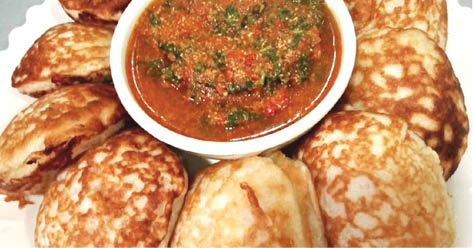With all the depressing issues trending across social media, I’ve been in turns angry, sad, and heartbroken by the turn of events that I decided to divert my attention to something many of us turn to in times of great stress: comfort food. And what better comfort food could I possibly table if not the delicacies offered at breakfast in the northern part of Nigeria? Fondly called Arewa, the region is home to quite a good number of ethnicities, with just as many cultures, each as rich and as distinct as the other. Growing up in Kaduna at its potpourri best meant I had the luxury and privilege of enjoying many cultures, food included. But of course to talk about all that would require a whole encyclopedia-like volume. Therefore I’m going to focus on some of my personal favorites over the years.
If you just thought ‘Is he really going to spend his 900-or-less words this week talking about Waina Da Miya?’ then you’re absolutely right. Ah, Waina. That scrumptious pancake-like disc of deliciousness that is probably the best of all Arewa breakfasts. Made from a batter of corn flour or ground rice, it’s poured into a ‘tanda’, an oiled clay surface with a fire underneath. The result is a soft, chewy disc that can be eaten with soup (Miyar Taushe, basically vegetable soup) and beef, or chewy ‘biscuit bone’ (soft cartilage-rich bones from beef). Topping it up with Man Shanu, molten (or blanched, really) fresh unprocessed cream cheese from cow’s milk, seasoned with a little salt and fried onions, drizzled all over. And the perfect beverage to wash it down with? Kunun Zaki.
Moving on to the next best Arewa breakfast, please don’t laugh at me. Nicknamed ‘double fire’, or in Hausa ‘Dumame’, it’s usually warmed up leftovers of Tuwo (rice, or maize) from the previous night’s dinner. Nobody who’s ever had the privilege of eating Dumame will tell you it’s not inexplicably tasty, and also not mention that it’s confounding, as it tastes much better than the fresh batch. While it’s best-paired with Miyar Kuka – a thick, viscous soup that is ridiculously enjoyable – it’s also great with Okra soup, or even Miyar Dage-Dage (loose name for what Nigerians call ‘stew’). A sprinkling of Garin Yaji (powdered pepper) also does wonders for the taste.
Still on Dumame, though, I’ll have to say the Nupe version is hands-down the best, especially that of Tuwon Shinkafa, and peppery Miyar Wake (beans soup), with chunks of dried fish, and hosting soft-cooked chunks of beef accompanied by a generous accompaniment of Daddawa (locust beans). The only problem with this version is, if you are not careful, you will end up over-eating. It’s that mouth-wateringly good. If you’ve never tasted this one, then believe me when I say you’re in for a treat.
- Buhari orders action on 5 babies kidnapped in Anambra
- When will Ortom invite Wike to inaugurate projects in Benue
Finally, there’s Koko, a kind of pap, sweetened or not depending on your taste buds, beautifully paired with Kosai (or Akara, if that’s more your thing). This is also a perennial favorite via the holy month of Ramadan, but can be enjoyed any time of the year. There are variants of the Kosai itself, as that of the Koko too. I’m yet to taste one I don’t like. And the best part? You can toss in fried yam to make things more interesting. The fried-yam-and-Kosai combo is particularly popular with students, as a cheap and tasty meal, mostly dinner, most times eaten communally depending on the time of the semester.
I’m sure you’re wondering, ‘why three?’ Well, I did mention that I’m going to list my favorites, not the entire menu and retinue of breakfasts of Northern Nigeria. I mean there’s Sinasir, a close cousin of Waina which I suspect has Arabian origins. But hey, I’m not a food historian. There’s Dan Wake (directly translation from Hausa to mean ‘Son of Beans’), but it’s actually an exquisitely tasty type of dumpling made mostly from a mix of corn flour, and you guessed right, beans flour, and when done, drizzled with real groundnut oil, fried onions, and powdered pepper. The effect on one’s taste buds is better experienced than imagined.
There are many more, with varying degrees of deliciousness, but unfortunately, I don’t have the space to daydream about them at length. The good part is that there are many food vendors who make these delicacies locally. If you’re familiar with them, then I say lucky you. If not, then what are you waiting for? Go ahead; make your day by having a taste. And look out for signs that you – or your family and friends – are committing what is called ‘Santi’. Maybe one day I’ll explain what that’s all about in a whole article. For now, enjoy your breakfast, and be safe.

 Join Daily Trust WhatsApp Community For Quick Access To News and Happenings Around You.
Join Daily Trust WhatsApp Community For Quick Access To News and Happenings Around You.


